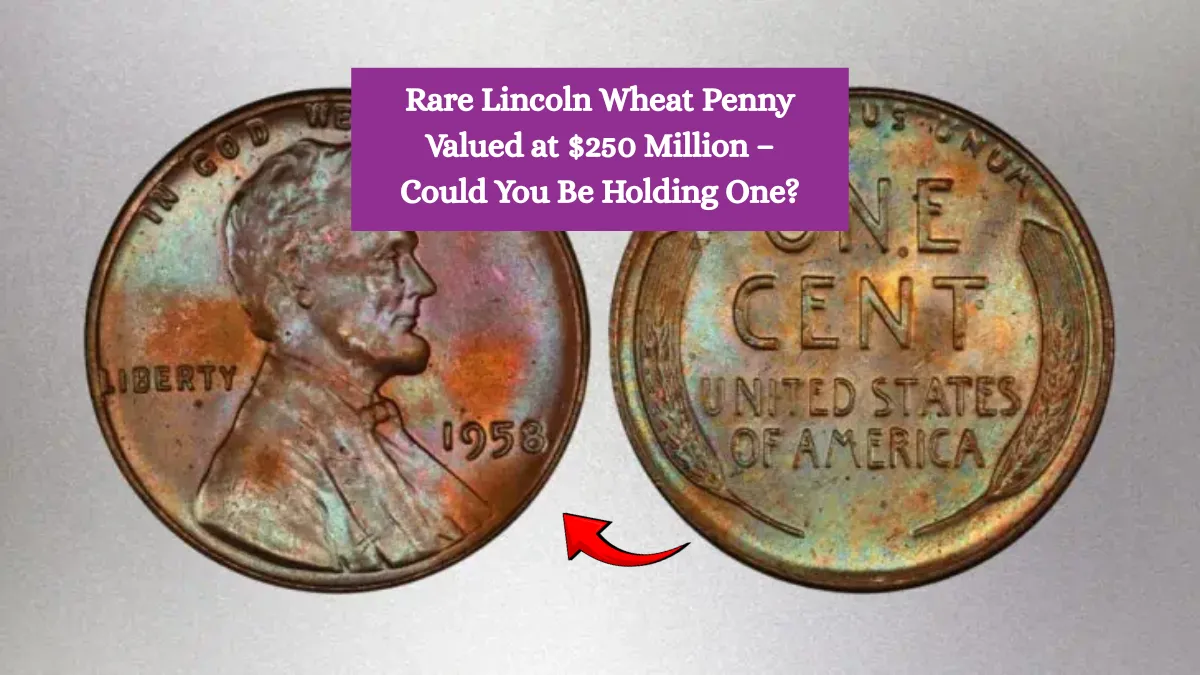Think pennies aren’t worth much? Think again. Deep within the world of coin collecting lies a legend—a Lincoln Wheat Penny so rare and mysterious, it’s rumored to be worth an astonishing $250 million. While it might sound unbelievable, history shows that ultra-rare coins can demand jaw-dropping prices from wealthy collectors.
You might even have one in your pocket change, a jar at home, or a forgotten coin album. So what makes this penny so valuable—and could you be holding the coin of a lifetime?
A Brief History of the Lincoln Wheat Penny
The Lincoln Wheat Penny, also known as the Wheat Cent, was minted from 1909 to 1958. It features Abraham Lincoln on the obverse and two wheat stalks framing the words “ONE CENT” on the reverse. It was the first U.S. coin to depict a real person, issued to commemorate Lincoln’s 100th birthday.
While most of these pennies are common and worth only a few cents or dollars, a few rare versions—due to minting errors, metal composition, or historic anomalies—are worth millions.
The $250 Million Lincoln Penny – Fact or Numismatic Folklore?
There are whispers in the collector world of a one-of-a-kind Lincoln Wheat Penny, struck in error or prototype form, that has never been officially confirmed by the U.S. Mint but is believed to exist. This coin is often described as:
- A 1943 Lincoln Wheat Penny struck in copper, not steel
- Or a 1944 Wheat Penny struck on a steel planchet, the reverse of what should have happened
- Or a pattern coin made from experimental materials, never meant to be released
One such 1943 copper penny sold at auction for over $1.7 million. But collectors speculate that a flawless, certified unique example, combined with historic provenance and condition, could fetch up to $250 million in a private sale.
Why 1943 Pennies Are the Key
In 1943, the U.S. Mint switched from copper to zinc-coated steel to save copper for World War II. As a result:
- Billions of steel cents were made in 1943
- A few copper planchets were accidentally left in the machines from 1942
- These copper 1943 pennies are now legendary rarities
Fewer than 20 authentic 1943 copper pennies are known to exist, and they command millions at auction depending on condition and origin.
The most famous sale:
A 1943-D Copper Penny (struck in Denver) sold in 2010 for $1.7 million. It remains one of the most valuable pennies ever sold publicly.
But experts speculate that a perfect, uncirculated version with full red luster—certified by PCGS or NGC—could be the most valuable coin ever sold, possibly worth $250 million in the right market.
How to Spot a Rare Lincoln Wheat Penny
Here’s what to look for in your collection:
1. 1943 Copper Penny
- Color: Bronze/copper tone instead of gray steel
- Will not stick to a magnet (steel does)
- Mint mark: May be blank (Philadelphia), “D” (Denver), or “S” (San Francisco)
- Extremely rare—fewer than 20 known
2. 1944 Steel Penny
- Should be copper, but if you find a steel one—it’s a major error
- Will stick to a magnet
- Only a few known examples
3. Early Mint Errors (1909–1922)
- Look for off-center strikes, doubled dies, or coins with no mint marks
- The 1909-S VDB penny (first year with designer initials) is worth $1,000+
4. High Grades
- A common date Wheat Penny in MS67 or higher (perfect condition) can be worth thousands
- Coins graded and slabbed by PCGS or NGC fetch the highest prices
Other Rare Lincoln Pennies Worth Big Bucks
Even if you don’t have the $250 million penny, these are still worth searching for:
1909-S VDB
- Only 484,000 minted
- Value: $800–$5,000+
1914-D
- Scarce in any grade
- Value: $200–$3,000+
1922 No D (Weak D) Penny
- Denver was the only mint, but some coins lack the “D”
- Value: $500–$10,000
1955 Doubled Die Obverse
- Clear doubling in “LIBERTY” and “IN GOD WE TRUST”
- Value: $1,000–$15,000+
Could a $250 Million Penny Be Hiding in Your Home?
It’s entirely possible. Many rare coins were accidentally saved in jars, albums, or drawers for decades. That includes war-era pennies like the 1943 copper or 1944 steel cents, which were often mistaken as regular coins.
To check if you have a winner:
- Sort your Wheat pennies by year and mint mark
- Use a magnet to test 1943 and 1944 coins
- Look for doubling, off-center strikes, or unusual colors
- Get suspicious coins authenticated by a reputable grading service (PCGS or NGC)
Final Thoughts
The $250 million Lincoln Wheat Penny may sound like a collector’s fantasy, but the truth is, coin history is filled with unexpected finds. From mint errors to experimental strikes, rare coins often surface in the most unlikely places—garage sales, old jars, or childhood piggy banks.
So before you dismiss that penny as just another piece of copper, take a closer look. It might just be the coin that changes your life.
Tip: Want to increase your odds? Check old rolls of pennies from banks or estate sales. Wheat pennies turn up more often than you’d think—and one day, the legendary $250 million piece may emerge.
